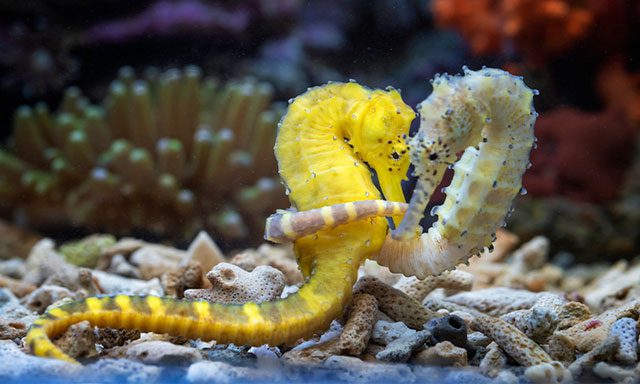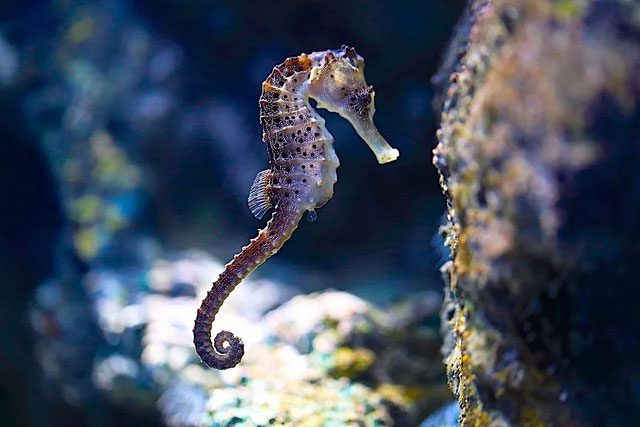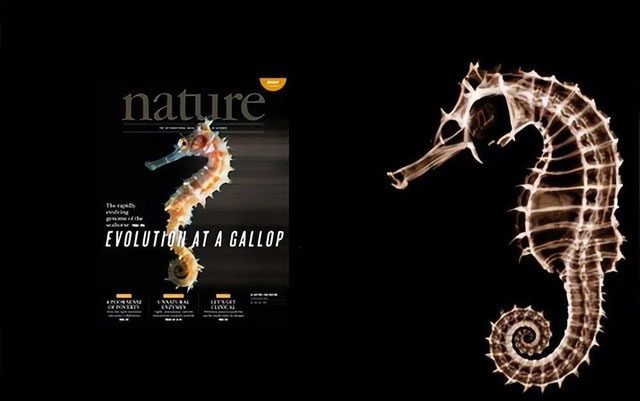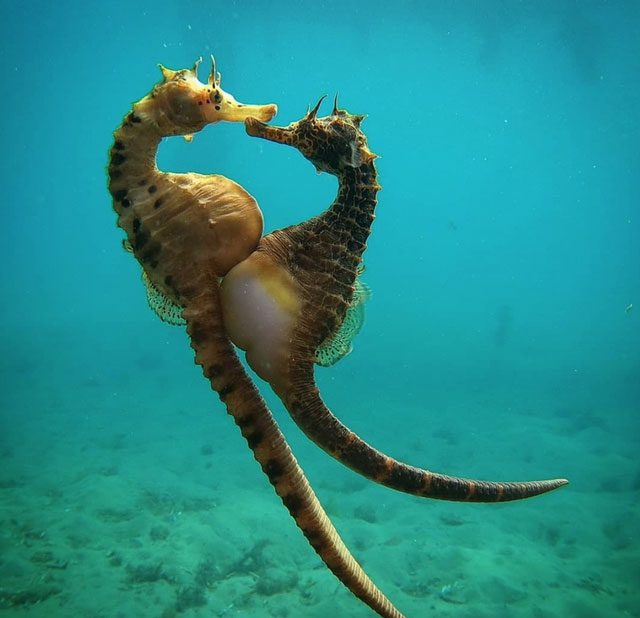When mentioning seahorses, people often think of their strange appearance and mysterious behavior. This amazing creature is nicknamed “the creature that nature created when drunk”!
The Strange Shape of the Seahorse
When people first see a seahorse, they are often shocked by its unusual appearance. Some describe it as “the creature that nature created when drunk.” So, what makes the seahorse unique and wonderful?
The seahorse has a very distinct appearance that no other fish can match. Its body is slender, resembling a chain of small beads, and its entire form curves into an S-shape. The head of the seahorse resembles that of a horse, with a pointed snout and bright eyes. Whether underwater or on land, this unique appearance immediately catches attention.

The seahorse has a very distinct appearance.
Beyond its looks, the seahorse also exhibits very unique behavior. Seahorses almost always float upright in the water, using gentle tail movements to maintain balance. This behavior is quite rare among fish. Additionally, seahorses have the ability to rotate 360 degrees around their entire bodies, allowing them to move freely in the water.
However, the reason why seahorses are dubbed “the creature that nature created when drunk” is not solely due to their appearance and behavior. More importantly, it is related to how seahorses reproduce. Unlike other fish species, male seahorses take on the responsibility of incubating the young.
The female seahorse lays eggs inside the male seahorse, forming a womb-like structure within its body to protect and incubate the eggs. During the incubation process, the male seahorse continuously moves its body to keep the eggs fresh and well-oxygenated. This is one of the biggest differences between seahorses and other creatures, and one of the reasons they are known as “the creature that nature created when drunk.”
 The seahorse almost always floats upright in the water.
The seahorse almost always floats upright in the water.
The unique appearance and behavior of seahorses have captured the deep interest of scientists. By studying seahorses, they hope to uncover their mysteries and gain more knowledge about biological evolution and adaptability.
The Unique Reproduction of Seahorses
Seahorses are wonderful and unique creatures known worldwide for their distinctive reproductive method. Especially, the phenomenon of male seahorses becoming pregnant has attracted widespread interest and curiosity. Why do male seahorses get pregnant while females do not? What scientific principles lie behind this phenomenon?
First, let’s explore the physiological structure of male seahorses. Unlike other animal species, male seahorses possess a pair of organs called “pouches.” These pouches are located on the abdomen of the male seahorse and serve a function similar to that of a female’s uterus. When a female seahorse lays eggs, the male inhales the eggs into its pouch, where fertilization and embryo development occur.
So why have male seahorses developed this unique reproductive method? Scientists believe that this is related to competition within the seahorse population and the need to protect their offspring. Seahorses live in shallow waters and often swim in schools. Since female seahorses are larger and easier targets for predators, male seahorses choose to take on the responsibility of giving birth, placing the eggs in their pouches for protection. This way, female seahorses are less threatened by predators and are better protected.

Seahorses live in shallow waters and often swim in schools.
The process of male seahorses becoming pregnant is also associated with unique mating behavior. During the mating process of seahorses, the male interacts closely with the female in a motion known as “dancing.” The female seahorse will release her eggs to the male through a secretion process, and the male will use its tail to absorb the eggs into the pouch. This mating behavior not only allows the male seahorse to care for the offspring but also increases the chances of successful reproduction for the female seahorse.
For scientists, discovering the real reasons why male seahorses become pregnant remains a mystery to be solved. However, this phenomenon provides new insights and research directions for the field of biology.
The unique reproductive method of seahorses brings us many new thoughts. The pregnancy in male seahorses, rather than females, serves as evidence of the miraculous evolutionary adaptations in nature. This distinctive reproductive strategy not only provides an advantage for the survival of the seahorse population but also helps us gain deeper insights into the diversity of life. In the future, there are still many unanswered questions waiting for scientists to explore, which will lead to breakthroughs and new advancements in the field of biology.

The unique reproductive method of seahorses brings us many new thoughts.
The Ecological Role of Seahorses
Seahorses are amazing creatures living in the ocean, with a unique ecological role and significant importance in marine ecosystems. Seahorses play an essential role in the food chain. They are marine animals that feed among seagrasses on the ocean floor.
Due to their special feeding habits, seahorses primarily eat algae and plankton, helping control the populations of these marine organisms. At the same time, seahorses are also predators of many small fish living at the bottom, balancing the numbers of different species in the marine ecosystem by preying on these small fish. The existence of seahorses maintains the balance of the food chain on the ocean floor and ensures the stability of the entire marine ecosystem.
Seahorses are also important “scavengers” in the marine ecosystem. In the seagrass bed, seahorses often eat various types of algae and remove debris and impurities from the seagrass leaves by consuming these algae. This clean-up behavior not only keeps the seagrass bed tidy but also encourages the growth and reproduction of seagrasses.

Seahorses play an important ecological role in regulating the food chain.
Since seagrass is a vital part of the marine ecosystem, providing habitat, food, shelter, and playing a crucial role in maintaining water quality and protecting marine biodiversity, seahorses help keep seagrass beds healthy by removing debris from the seagrass leaves, indirectly promoting the balance of the entire marine ecosystem.
As an essential part of the marine ecosystem, seahorses have an important ecological role in regulating the food chain, removing debris from seagrass beds, and having high reproductive rates. Their existence and reproduction provide a balanced food chain and a suitable habitat for marine organisms, maintaining the stability and diversity of marine ecosystems. It is our responsibility and duty to protect seahorses and the marine ecosystem in which they live.


















































